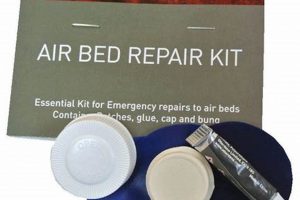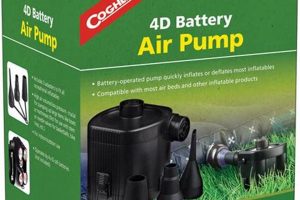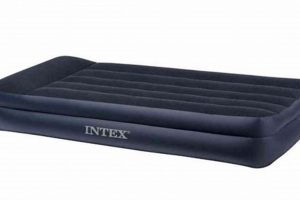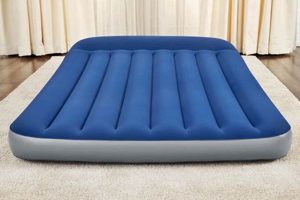The restoration of inflatable sleeping surfaces to a functional state after a breach has compromised their air retention capabilities constitutes a specific maintenance procedure. This process addresses the issue of air escaping from the mattress, rendering it less supportive and comfortable for use. Addressing the compromised area ensures the continued utility of the item.
Addressing damage to these sleeping solutions is economically advantageous and promotes sustainability. Repairing a damaged mattress is more cost-effective than purchasing a replacement, reducing waste and conserving resources. The ability to restore the integrity of such products extends their lifespan and diminishes the environmental impact associated with disposal.
The subsequent sections will detail methods for pinpointing the source of air loss, discuss appropriate patching materials and techniques, and provide preventative measures to minimize future occurrences of similar problems. These measures ensures the continued functionality of the inflatable mattress.
Guidance on Addressing Compromised Inflatable Sleeping Surfaces
The following points offer practical advice for mitigating issues associated with air loss in inflatable mattresses, ensuring prolonged usability and comfort.
Tip 1: Identify the Source of the Leak: Submerge the inflated mattress in water, section by section, observing for air bubbles. Alternatively, apply a soapy water solution to the surface and watch for bubble formation, indicating the location of the breach.
Tip 2: Thoroughly Clean the Affected Area: Before attempting any patching procedure, cleanse the area surrounding the leak with isopropyl alcohol to remove dirt, oils, and other contaminants that may impede adhesion.
Tip 3: Select an Appropriate Patch Material: Opt for vinyl repair patches specifically designed for inflatable products. These patches are typically waterproof and possess the flexibility required to conform to the mattress surface.
Tip 4: Apply Adhesive Sparingly and Evenly: Use a small amount of adhesive recommended for vinyl repair and spread it thinly and uniformly across both the patch and the area surrounding the leak. Avoid excessive adhesive application, which can compromise the bond.
Tip 5: Apply Pressure During the Curing Process: After applying the patch, exert firm and constant pressure for the duration specified by the adhesive manufacturer. This promotes optimal adhesion and prevents air pockets from forming.
Tip 6: Allow Sufficient Curing Time: Before reinflating the mattress, allow the adhesive to cure completely, adhering to the manufacturer’s recommendations. Premature inflation may compromise the bond and result in patch failure.
Tip 7: Consider Reinforcement for Large Tears: For tears exceeding a nominal size, reinforce the patch with an additional layer of material to enhance structural integrity and prevent recurrence of the issue.
Following these guidelines will enhance the success rate of mending compromised inflatable mattresses, reducing the necessity for replacement and extending the lifespan of the product.
The subsequent section will delve into proactive measures designed to minimize the likelihood of punctures and prolong the overall lifespan of the inflatable sleeping surface.
1. Pinpoint leak location
The precise identification of the leak source is the initial, critical step in the process of restoring an inflatable mattress experiencing air loss. Failure to accurately determine the point of egress renders subsequent repair efforts ineffective. This foundational aspect of restoration directly influences the success and longevity of the repair.
The correlation between accurate leak detection and effective mattress restoration is exemplified in practical scenarios. For instance, a slow leak may manifest as a gradual deflation over several hours, necessitating meticulous inspection. If a tear is not correctly identified, then the application of patching material is of no consequence. The correct assessment ensures that efforts and materials are directed at the area of concern, ensuring proper mattress function.
In conclusion, the ability to precisely locate the source of the leakage is a crucial element in the overall repair process. The success of any restoration attempt depends on this initial assessment. Failing this assessment means wasted effort and a continuation of the mattress’s loss of air.
2. Appropriate Patching Material
The selection of suitable patching material is a pivotal determinant in the efficacy of repairs to inflatable mattresses experiencing air loss. The material’s characteristics must align with the properties of the mattress and the nature of the damage to ensure a durable and lasting seal.
- Material Compatibility
The patching material must exhibit compatibility with the mattress’s composition, typically vinyl or PVC. Using an incompatible material, such as a fabric patch on a vinyl mattress, will likely result in poor adhesion and eventual failure. Compatible materials ensure a strong bond and prevent further air leakage.
- Flexibility and Elasticity
Inflatable mattresses undergo expansion and contraction during use, necessitating a patch material with adequate flexibility and elasticity. A rigid patch is prone to cracking or detachment under stress, compromising the repair. Materials with inherent flexibility accommodate these movements, maintaining a secure seal.
- Adhesive Properties
The efficacy of the patching material hinges on the adhesive’s capacity to form a robust bond with both the patch and the mattress surface. The adhesive must be waterproof and resistant to environmental factors, such as temperature fluctuations and humidity. An insufficient adhesive bond compromises the integrity of the repair, leading to recurrent air leakage.
- Durability and Resistance to Abrasion
Patches used on inflatable mattresses must be highly durable to prevent ruptures from reoccurring. The patch is the first line of defense and must be resistant to physical wear and tear. This will ensure that the patch lasts for as long as possible.
The strategic selection of patching material is therefore integral to achieving a successful and enduring solution to air leaks in inflatable mattresses. Each facet of the material, from compatibility to adhesive properties, contributes to the overall integrity of the repair, ensuring the continued functionality and lifespan of the mattress. If you do not select the correct patch, the leak will continue.
3. Surface preparation essential
Optimal repair of inflatable mattresses necessitates meticulous surface preparation prior to the application of any patching material. This process significantly influences the adhesive bond and, consequently, the longevity of the repair. Proper preparation removes contaminants and creates a conducive environment for effective adhesion.
- Contaminant Removal
The presence of dirt, oils, and other foreign materials on the mattress surface impedes the formation of a strong adhesive bond. Isopropyl alcohol is commonly employed to dissolve and remove these contaminants, ensuring a clean surface for patch application. The failure to remove such impediments results in a compromised repair that is prone to premature failure.
- Surface Roughening
Light abrasion of the area surrounding the leak, using fine-grit sandpaper, creates a slightly textured surface. This increases the surface area available for bonding and enhances the mechanical interlock between the patch and the mattress material. Excessive abrasion, however, may damage the mattress, underscoring the need for careful execution.
- Drying Time
Following cleaning, adequate drying time is essential to ensure complete evaporation of any residual cleaning agents or moisture. Moisture interferes with the adhesive’s ability to properly cure, weakening the bond. The duration of the drying period is dependent on the ambient temperature and humidity levels, with longer times required in humid conditions.
- Material Compatibility
The selected cleaning agents must be compatible with the mattress material to prevent degradation or damage. Harsh chemicals may compromise the integrity of the surface, rendering it unsuitable for repair. Isopropyl alcohol is generally considered safe for use on vinyl and PVC, the most common materials used in inflatable mattresses.
In summary, diligent surface preparation is not merely a preliminary step but an integral component of the mattress repair process. Proper cleaning, surface roughening, and drying ensure a robust and lasting repair, mitigating the likelihood of future air leaks and extending the useful life of the inflatable mattress. The patch will only work if the surface is prepared correctly.
4. Adhesive application technique
The method by which adhesive is applied directly influences the success and longevity of repairs to inflatable mattresses. Deviations from recommended techniques may result in compromised adhesion, leading to subsequent air leaks and necessitating further intervention. The procedure requires precision and adherence to established guidelines.
- Uniform Coating
The adhesive should be applied in a thin, uniform layer across both the patch and the prepared mattress surface. Inadequate coverage results in weak bonding points, while excessive application may create air pockets or prevent proper curing. A consistent film ensures maximal contact and adhesion. For instance, utilizing a small brush or applicator can facilitate even distribution, minimizing the risk of unevenness. Unevenness could mean the patch will not take at that point.
- Adhesive Selection
The chosen adhesive must be specifically formulated for use with the mattress material (typically vinyl or PVC) and compatible with the patch. Using an inappropriate adhesive, such as general-purpose glue, will likely result in a weak or brittle bond that fails under pressure. An adhesive designed for flexible plastics ensures optimal adhesion and resistance to environmental factors. Incorrect Adhesive selection is a bad decision and will result in the failure of the repair.
- Open Time Management
Adhesive manufacturers specify an “open time,” which refers to the period between adhesive application and patch placement. Adhering to this timeframe is crucial for optimal bonding. Prematurely joining the surfaces may trap solvents and prevent proper curing, while delaying beyond the open time may result in surface drying and reduced adhesion. Following the manufacturer’s guidelines ensures the adhesive retains the necessary tackiness for a secure bond.
- Bubble Prevention
The presence of air bubbles between the patch and mattress surface compromises the adhesive bond and creates potential points of failure. Applying the patch carefully and smoothing it outward from the center eliminates trapped air, maximizing contact between the adhesive and both surfaces. A roller or similar tool can assist in achieving uniform contact and removing air pockets. Leaving air bubbles will mean that the patch will not connect at that point, meaning the air mattress will not work.
Effective adhesive application constitutes a critical component of mattress restoration. The careful selection of adhesive, combined with precise application techniques, maximizes the likelihood of a durable and lasting repair. Adherence to these principles minimizes the risk of recurrent leaks and prolongs the functional lifespan of the inflatable mattress. Skipping steps or missteps could compromise the success of the patch on the leak.
5. Pressure during curing
The application of consistent pressure during the adhesive curing phase is a critical determinant of success in the context of air mattress repairs. Insufficient pressure compromises the adhesive bond, increasing the likelihood of future leaks. The principle relies on maximizing contact between the patch and the mattress surface throughout the curing process, enabling optimal adhesive cross-linking and a durable seal.
Consider a scenario where a patch is applied to an inflatable mattress with a significant tear. If adequate pressure is not maintained during the curing period, air pockets may form between the patch and the mattress material. These air pockets weaken the bond, creating pathways for air to escape. In contrast, consistent pressure, whether applied manually or via a weighted object, ensures uniform contact and facilitates a stronger, more reliable seal. Practical application involves using weights or clamps to apply constant force across the patched area, following adhesive manufacturer recommendations for pressure duration and intensity. This approach maximizes surface area contact and promotes robust adhesive bonding.
In summary, the application of pressure during curing is indispensable for achieving effective and long-lasting repairs on inflatable mattresses. This process ensures a robust bond between the patch and the mattress material, minimizing the risk of future air leaks. Adherence to recommended pressure levels and curing times enhances the probability of a successful repair, extending the lifespan of the mattress and reducing the need for frequent replacements. Thus, it is imperative that this stage be completed appropriately.
6. Curing time critical
The duration allocated for adhesive curing directly influences the efficacy of
any attempt to mend an inflatable mattress experiencing air loss. Premature use of a repaired mattress, prior to full adhesive set, compromises the structural integrity of the bond and increases the likelihood of subsequent leakage. The curing process allows the adhesive to fully cross-link and achieve its maximum bonding strength, a factor that dictates the repair’s longevity. For instance, vinyl adhesives often necessitate a minimum of 24 hours to cure completely, a timeframe stipulated by manufacturers to ensure optimal performance.
Failure to adhere to the specified curing time can manifest in several detrimental ways. The patch may peel away from the mattress surface under pressure, re-establishing the air leak. Alternatively, the adhesive may not achieve sufficient elasticity, resulting in cracks or tears around the patch perimeter as the mattress expands and contracts during use. A real-world example involves individuals who, in haste, inflate a repaired mattress within a few hours, only to discover the patch detaching under the weight of a person. Such instances underscore the practical significance of understanding and respecting the curing timeframe.
In conclusion, the curing period represents a non-negotiable element in the inflatable mattress repair process. Abbreviating this stage for the sake of expediency ultimately undermines the entire effort, rendering the repair ineffective and necessitating further intervention. The investment of time aligns directly with the achievement of a durable, leak-free solution, extending the functional lifespan of the mattress and mitigating the need for premature replacement.
7. Preventative Maintenance
Proactive measures designed to minimize the occurrence of damage to inflatable mattresses represent a critical component in prolonging their lifespan and reducing the necessity for repairs. Preventative maintenance strategies, when diligently implemented, can significantly decrease the frequency of air leaks and related issues.
- Appropriate Storage Practices
Storage conditions exert a considerable influence on the integrity of inflatable mattresses. Storing a deflated mattress in a clean, dry environment, away from direct sunlight and extreme temperatures, minimizes the risk of material degradation. Furthermore, folding the mattress loosely, rather than tightly, prevents creases and potential weak points from developing. Implementing these storage protocols reduces the likelihood of material failure and subsequent air leaks.
- Surface Protection During Use
The surfaces on which inflatable mattresses are deployed should be carefully assessed for potential hazards. Sharp objects, abrasive textures, and uneven terrains can puncture or damage the mattress material. Utilizing a protective barrier, such as a tarp or a thick blanket, between the mattress and the underlying surface provides a buffer against these risks. This practice diminishes the chances of accidental punctures and abrasions, preserving the mattress’s structural integrity.
- Regular Inspection and Cleaning
Periodic visual inspections of the mattress surface can identify potential problems before they escalate into significant issues. Checking for signs of wear, stress, or minor damage allows for timely intervention and prevents small issues from becoming larger ones. Regular cleaning with a mild soap and water solution removes dirt, debris, and other contaminants that may compromise the material over time. Consistent inspection and cleaning efforts help maintain the mattress’s condition and reduce the risk of air leaks.
- Proper Inflation Techniques
Overinflation of an inflatable mattress places undue stress on the seams and material, increasing the likelihood of bursting or developing leaks. Adhering to the manufacturer’s recommended inflation pressure is crucial to maintaining the mattress’s structural integrity. Using a pump with an automatic shut-off feature can prevent overinflation. Correct inflation practices prevent excessive strain on the mattress, minimizing the risk of damage and prolonging its usable life.
The systematic integration of these preventative measures into the routine care of inflatable mattresses significantly reduces the incidence of air leaks and other related problems. By prioritizing proactive maintenance, individuals can extend the lifespan of their mattresses, minimizing the need for frequent repairs or replacements and ensuring continued comfort and utility.
Frequently Asked Questions
This section addresses common inquiries regarding the diagnosis, procedures, and prevention associated with air leakage in inflatable mattresses. The information provided aims to offer clarity and guidance on this topic.
Question 1: How is a minor leak identified if audible air loss is not immediately apparent?
Submerging the inflated mattress in water, section by section, is recommended. The emergence of air bubbles indicates the precise location of the breach. Alternatively, a solution of soapy water applied to the surface will generate bubbles at the leak point.
Question 2: What materials are considered suitable for patching an inflatable mattress?
Vinyl repair patches, specifically designed for flexible plastics, are the preferred option. These patches offer superior adhesion and durability compared to general-purpose materials. In situations where a puncture is particularly large or oddly shaped, consider patching it with the same material as the air mattress.
Question 3: Is surface preparation prior to patching truly necessary?
Surface preparation is not merely recommended; it is essential. Contaminants such as dirt, oils, and residues impede adhesive bonding. Isopropyl alcohol serves as an effective cleaning agent, ensuring a clean, receptive surface for patch application.
Question 4: What constitutes an appropriate adhesive application technique?
The adhesive should be applied thinly and evenly to both the patch and the prepared mattress surface. Excess adhesive can hinder proper curing, while insufficient adhesive results in a weak bond. Avoid using too much, as this will prevent the patch from properly attaching to the air mattress.
Question 5: Why is pressure application during the curing process emphasized?
Sustained pressure during curing ensures maximum contact between the patch and the mattress, facilitating optimal adhesive cross-linking. Consistent pressure eliminates air pockets that could compromise the bond’s integrity.
Question 6: How does one minimize the risk of future air leaks in inflatable mattresses?
Adhering to proper storage protocols, deploying the mattress on protected surfaces, performing regular inspections, and avoiding overinflation are key preventative measures. These practices collectively extend the lifespan of the mattress and reduce the likelihood of damage.
These FAQs provide a foundational understanding of addressing air loss in inflatable mattresses. Diligent adherence to these guidelines enhances the prospects of successful repair and prolonged product lifespan.
The subsequent segment will delve into specific tools and equipment commonly employed in the repair of leaking inflatable mattresses, offering a practical overview of necessary resources.
Addressing Inflatable Mattress Air Loss
This discourse has elucidated the multifaceted nature of addressing air leakage in i
nflatable mattresses, emphasizing the criticality of precise leak identification, appropriate material selection, meticulous surface preparation, accurate adhesive application, controlled curing, and proactive maintenance. The efficacy of mending leaking air mattress repair efforts hinges on a thorough understanding and diligent execution of these interlocking elements. Compromising any stage of this process diminishes the probability of a successful and enduring repair.
The economic and environmental benefits of extending the lifespan of inflatable mattresses through effective restoration techniques are substantial. Continued adherence to these principles will contribute to reduced consumer expenditure, decreased landfill waste, and a more sustainable approach to the utilization of inflatable sleeping solutions. Diligence in addressing air mattress damage ensures prolonged utility and minimized environmental impact.







